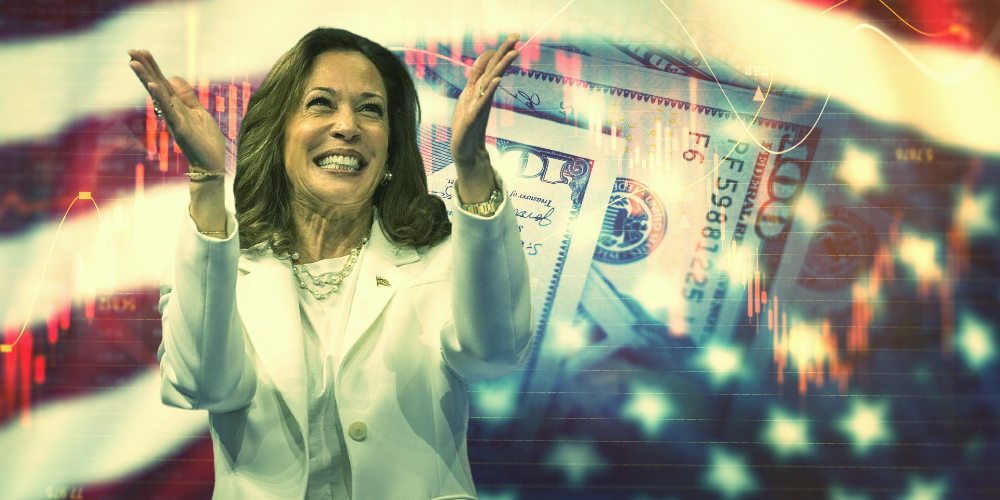(DLacalle)—In a recent interview with CNN, Kamala Harris said that Bidenomics is working and that she is “proud of bringing inflation down.”
However, the Bureau of Labor Statistics published the latest CPI at 2.9%, despite annual inflation being 1.4% when she took office. Inflation is a disguised tax and accumulated inflation since January 2021, when the Biden-Harris administration started, has increased more than 20%.
Of course, Democrats blame inflation on the war, the pandemic, and the science-fantasy concept of “supply chain disruptions.” No one believed it, because most commodities have declined and supply tensions disappeared back to normality, but prices continued to rise.
As a result, Harris invented the concept of greedy grocery stores and evil corporations to blame for inflation and justify price controls. Is it not ironic? She blames grocery stores and corporations for inflation, but when price inflation drops, she proudly takes credit.
The reality is that the Kamala Harris plan, like all interventionist governments, creates and strives for inflation. Inflation is a hidden tax. Governments love it and perpetuate it by printing money through deficit spending and imposing regulations that harm trade, competition, and technological creative destruction. Big government is big inflation.
Inflation is the way in which the government tricks citizens into believing that administrations can provide for anything. It disguises the accumulated debt, quietly transfers wealth from the private sector to the government and condemns citizens to being dependent hostages of government subsidies. It is the only way in which they can continue to spend a constantly depreciated currency and present themselves as the solution. Furthermore, it is the perfect excuse to blame businesses and anyone else who sells in the currency that the government creates.
Kamala Harris will do nothing to cut inflation because she wants inflation to disguise the monster deficit and debt accumulation. In the latest figures, the deficit has soared to $1.5 trillion in the first ten months of the fiscal year. Public debt has soared to $35 trillion, and in the administration’s own forecasts, they will add a $16.3 trillion deficit from 2025 to 2034. It is worse. The previously mentioned figure does not include the $2 trillion in additional debt coming from Kamala’s economic plan.
Harris is aware that her proposals to impose an unrealized capital gains tax, an economic aberration, and other tax hikes will not generate the $2 trillion in additional taxes she seeks. So, she needs the Fed to monetize as much as possible, eroding the US dollar’s purchasing power and making all Americans poorer in the process, only to blame corporations and grocery stores later. Furthermore, it is a way to present the government as the solution to the problem they create, promising the lunacy of price controls and enormous subsidies in a constantly depreciated currency.
It is a perfect plan to nationalize the economy in the style of Peronist socialism in Argentina.
Increase spending, deficits, and debt, making the size of government larger on the way in. Monetize as much debt as possible and cut rates to make it easier for the bankrupt government to borrow. When deficits balloon and inflation soars, increase taxes to the private sector and hike rates, which increases further the size of government in the economy. And you blame corporations?
Governments do not reduce prices. Governments create and perpetuate inflation by printing currency that loses value every year.
Corporations, landlords, and grocery stores do not create or increase inflation; they reduce it through competition and efficiency. Even if all corporations, grocery stores, and landlords were evil and stupid at the same time, they would not make aggregate prices rise and consolidate a constant trend of increases. For the same quantity of money, even a monopoly would not be able to increase aggregate prices. The only one that can make aggregate prices rise, consolidate, and continue increasing, although at a slower pace, is the government issuing and printing more currency than the private sector demands.
By admitting that the deficit will soar by $16.3 trillion in ten years in a budget that expects record revenues, no recession, and continued employment growth, the Harris team is conceding that they will strive for inflation to dilute the currency in which that debt is issued… and make you poorer.
Interventionists argue that the government does not have a budget constraint, only an inflation constraint, and can always tax the excess money in the system. Beautiful. This implies an increase in the size of the government during periods of economic expansion and further government expansion during periods of perceived normalcy. The government receives an enormous transfer of wealth from the productive sector, resulting in the creation of a dependent citizen class.
High taxes are not a tool to reduce debt. High debt and high taxes are tools to confiscate the productive sector’s wealth and create a subclass of dependent citizens.
Socialism redistributes middle-class wealth to bureaucrats, not rich to poor.
Massive government spending, constantly increasing taxes, and printing money. A plan to reduce the economy to serfdom.
Harris’ economic plan is not aiming to reduce inflation but to perpetuate it. Indeed, this economic policy mirrors Argentina’s 21st-century socialism, and it threatens the US dollar’s status as the world’s reserve currency. The government does not determine the level of confidence in a currency. When confidence in a currency declines, it does so quickly. Saying it will not happen in the US because it has not occurred yet is the equivalent of driving at 200mph and saying, “We have not killed ourselves yet; accelerate.”.
About the Author
Daniel Lacalle (Madrid, 1967). PhD Economist and Fund Manager. Author of bestsellers “Life In The Financial Markets” and “The Energy World Is Flat” as well as “Escape From the Central Bank Trap”. Daniel Lacalle (Madrid, 1967). PhD Economist and Fund Manager. Frequent collaborator with CNBC, Bloomberg, CNN, Hedgeye, Epoch Times, Mises Institute, BBN Times, Wall Street Journal, El Español, A3 Media and 13TV. Holds the CIIA (Certified International Investment Analyst) and masters in Economic Investigation and IESE.



